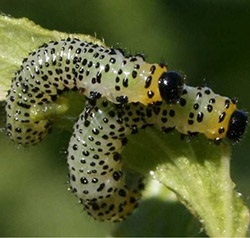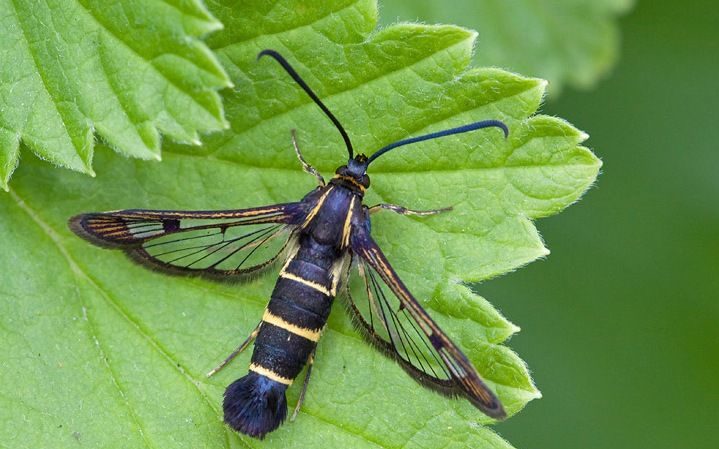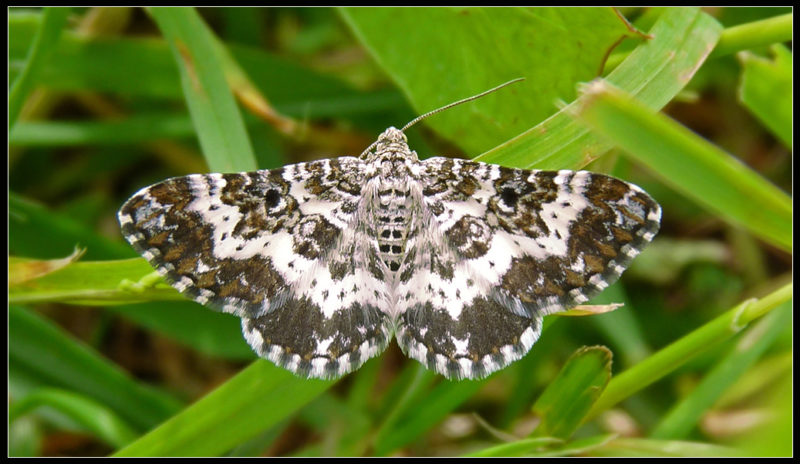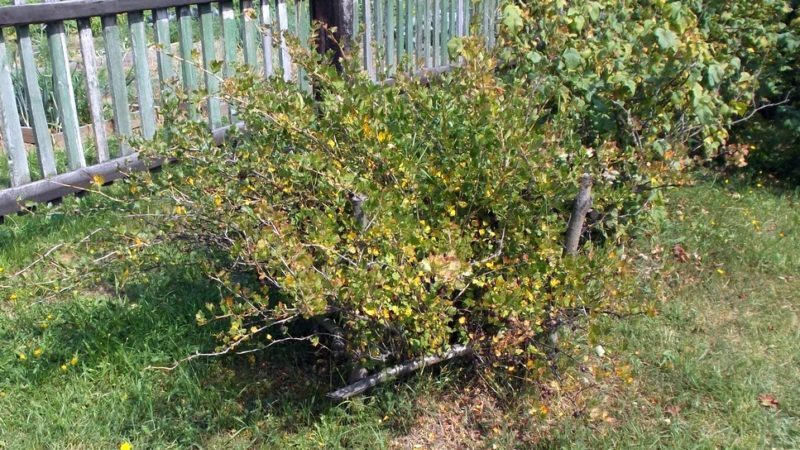How, when and how to process gooseberries from caterpillars, if there are already berries
Gooseberry is a delicious berry that is eaten fresh or used for preservation. But in order to harvest a rich harvest at the end of the season, you need to make sure that the plant does not get sick and does not suffer from pests. The latter can destroy an adult bush in just a few days. Preventive measures and a combination of various methods of pest control will help prevent this. How to process gooseberries from caterpillars, if there are already berries, we will tell in the article.
The content of the article
Signs of caterpillar infestation on gooseberries
If you detect a pest in a timely manner and take measures to combat it, you can save the harvest and planting of gooseberries as a whole.
How to recognize a pest
A visual inspection helps to determine if the gooseberry is infested with pests.
Main features:
- small cobwebs and a whitish bloom appear on the leaves and stems;
- bite marks are visible on the leaf plates;
- when digging up a bush, insect larvae, nests and traces of mechanical damage are found on the roots of the plant;
- the plant is depressed, the foliage turns yellow and falls off;
- gooseberry fruits are eaten by insects, turn black and fall to the ground.
What types of caterpillars do gooseberries eat?

Who eats gooseberry leaves and fruits:
- Sawfly. A dangerous and gluttonous pest. A winged insect with a black head and yellow legs. This pest waits out winter in the pupal stage, and in the spring adult insects appear, which lay eggs on the underside of the leaf. After a couple of weeks, larvae hatch from them, which first actively feed on leaves and buds, and then move on to berries.
- Gooseberry moth. It is a small gray butterfly with brown stripes on its wings. In spring, the female lays eggs in the ovaries. Small green caterpillars hatch from them, which devour flowers. If the defeat occurred gradually, the caterpillars move to fruits, gnawing the pulp of the berries from the inside. The fruits in this case begin to blush ahead of time, and then rot.
- Currant glass bowl. The butterfly attacks the plant when buds are forming on the gooseberry. The hatched white caterpillars with a brown head ignore the foliage, their goal is to get inside the shoots and feed on the sap, gnawing out all the insides.
 Butterfly currant glass
Butterfly currant glass - Moth. It feeds on plant foliage. It waits out winter in the upper layers of the soil, and with the onset of warmth begins to actively feed. After flowering, the caterpillars pupate, and after a month new butterflies hatch, laying eggs on the back of the leaf plate. During the season, the colony is renewed 3-4 times, and with a strong infection, the foliage is completely destroyed in a few days.

Harm done
Besides the destroyed crop, caterpillars are dangerous for other reasons.
Firstly, the pest can spread to neighboring plants and destroy not only the gooseberry crop, but also, for example, black currant. In addition, plants are weakened and may not survive the cold winter.The same bushes that release green leaves in spring will not be able to form ovaries and fruits, depriving the gardener of a second harvest in a row.
Ways to get rid of caterpillars on gooseberries during fruiting
It is best to deal with caterpillars on berries and inside them in a complex way, combining various methods.
Chemicals
In case of severe damage to the bushes by pests, insecticides are used. In this case, the berries are eaten only a month after the last processing, so that the decomposition of harmful substances occurs.
Apply:
- "Decis". It affects caterpillars an hour after treatment; the protective effect lasts up to two weeks in clear weather. It is used no more than 2 times in one season.
- "Kinmix". It takes effect one hour after application, protects up to 3 weeks if there was no rain. Also used no more than 2 times per season.
- «Iskra-M". A popular product that fights pests of different types. Protective properties last up to 3 weeks.
If the caterpillars appeared shortly before harvest, it is recommended to use biological products that are safe for humans and are easily washed off with water. These are "Lepidocid", "Bitoxibacillin", "Fitoverm".
Keep in mind that the action begins gradually, so the result will be noticeable after 5-6 days. All procedures should be carried out strictly according to the instructions, taking into account the specified temperature and cooking proportions.
Traditional methods
To prevent the worms from laying eggs and gnawing the leaves and berries, the gooseberry bushes are moistened with water and then sprinkled with ash... The procedure is carried out regularly, immediately after the ash is washed off by the rain.
Use and tobacco infusion... 1 kg of tobacco dust is infused in 10 liters of water for 24 hours, filtered and sprayed once a week.
Pests are also deterred by an infusion of dry mustard... 3 tbsp. l. mustard is diluted in 5 liters of water and insisted for 24-48 hours. After straining, add another 10 liters of water and a small amount of liquid soap (2-3 tablespoons), due to which the infusion will stick to the leaves and berries. Spraying is carried out once a week or after every rain.
Important! The described funds are used regularly. With a single application, the effect is negligible.
Agrotechnical techniques
Gooseberry bushes are regularly inspected for cobwebs or plaque, curled or gnawed leaves... Fallen branches, fruits and leaves are collected and burned so that the larvae preserved on them do not go underground for wintering or move to other plants.
Watering is carried out at the root, and the mulch is changed every 2-3 weeks in order to avoid soil contamination and re-infestation of the pest next year.
Important! Don't neglect sanitary pruning. Sometimes removing a few diseased shoots saves the crop.
When planting, maintain the recommended distance between bushes and rows. Strong thickening leads to the rapid spread of the caterpillar colony. Plant oregano next to it garlic, mustard and green onion - the intense smell of these plants repels pests.
Mechanical methods
Before treating the bushes with insecticides, biological products or folk infusions, it is recommended to reduce the number of pests by mechanical action.
When frightened, the caterpillars fold into a ring and fall down, which allows them to be collected and destroyed. For this, a cloth is spread around the trunk, and the bush is vigorously shaken several times. The fabric with the fallen pests is rolled up and burned.
If the gooseberry is hit by a moth, this method is not used. Damaged berries and those that only show signs of caterpillar vital activity are cut off by hand and burned. This will prevent the pest from moving to new fruits and reduce damage.
Features of pest control in different periods
Insect control methods largely depend on the period of development at which the pest attack occurred.
In the dormant stage, chemical agents can be used, but during flowering, only a mechanical method and folk methods are used... The active substances in pesticides are dangerous for bees, which affects the pollination process and the formation of ovaries.
Chemistry is allowed to be used during the fruiting period, but not before harvesting. After the last treatment, at least a month must pass, otherwise there is a risk of harming your health.
How to deal if caterpillars have eaten leaves and berries
In addition to pesticides and biological products, ammonia is considered an effective remedy. Its specific smell repels pests.
Before using the solution, part of the caterpillars is removed mechanically (by hand or by shaking the bush). Then in 10 liters of water, stir 2 tbsp. l. ammonia. The bushes are sprayed 2-3 times with a break of 7-10 days.
What to do if the caterpillars are inside the berries
In such cases, all damaged berries are harvested by hand and burned to reduce the number of pests next year.
All fallen berries are also subject to destruction so that the larvae do not move into the soil for wintering.
After that, the bushes are treated with biological products or folk remedies in order to save part of the crop and stop the spread of caterpillars in the garden.
Read also:
Caterpillar-resistant gooseberry varieties
To reduce the risk of pest infestation, plant varieties that are resistant to insect attacks in your area:
- Varieties of early ripening - Ural Emerald, Prune, Rodnik.
- Mid-season - Grushenka, Kolobok, Northern Captain.
- Late ripening - Defender, Cooperator, Leningrad.
Preventive measures

At the end of autumn, all plant residues are piled up and destroyed. The earth is loosened. If there were a lot of pests this season, the topsoil (about 10 cm) is replaced with a new one.
So that insects that remain in the soil for wintering cannot get to the surface in spring and harm the plant, the trunk circle is covered in autumn with dense black agrofibre... Immediately after the snow melts, the soil is spilled with boiling water, which will destroy the larvae of pests that have escaped death from frost.
Immediately after this, dry, old and diseased branches are removed, the cuts are sprinkled with wood ash. Loosening of the soil is carried out after each watering. Even tiny weed growths are removed. The trunk circle is mulched with straw or humus.
Important! In a well-kept garden, plants suffer less from pests and diseases.
Good advice and mistakes to avoid
Experienced gardeners do not recommend planting gooseberries in the area where black currants grew before. These crops have common diseases and pests.
Look for varieties that are renowned for insect resistance and do not neglect preventive measures early in the season. Be sure to treat the shrub with Inta-Vir before the flowers appear. This is an effective insecticide that destroys the larvae at the very beginning of their development and does not allow further reproduction.
Conclusion
Remember, a lot depends on soil preparation in late season and early spring. Cleaning up the garbage, covering the near-trunk circle with a film and spilling the soil with boiling water will not allow the surviving larvae to get to the surface.
If the defeat of the gooseberry still occurs, select the methods of struggle, starting from the period in which the pest became active. Improper use of chemicals can ruin the crop even at the beginning of its formation. Conduct regular inspection of plantings to identify insects at the very beginning of their appearance, preventing the colonies from spreading.